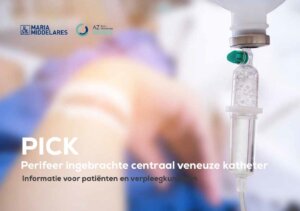PICC line
What is it?
What is it?PICC is an abbreviation for peripherally inserted central catheter. It is a thin tube (catheter) that will be inserted into a vein in your upper arm. The tip of the catheter is positioned in a large vein just above the heart. Medication or liquid nutrition can be administered through the catheter for a condition that requires treatment for a prolonged period of time. The PICC line can remain in place from six weeks to three months.
Why a PICC line?
The treatment of your condition requires long-term administration of medication through the bloodstream. Repeatedly puncturing the blood vessels in your hand or arm may damage them. That will make it increasingly difficult and painful to place a peripheral infusion line. Frequent administration of irritants such as chemotherapy, antibiotics or parenteral nutrition may also damage the vessel wall.
A PICC line can prevent these problems because it is placed in a large vein. Irritating fluids are immediately highly diluted by the large volume of blood that flows through the large vein where the catheter tip is positioned.
How is a PICC line placed?
How is a PICC line placed?It is very important that the PICC line is sterile when placed to prevent infections. Therefore, the PICC line is inserted in the operating theatre. This process takes approximately 30 minutes. The arm is covered with sterile cloths and disinfected up to the underarm area. A local anaesthetic is applied to the puncture site. The catheter is inserted through a vein in your arm and moved up to above the heart. You will feel little or nothing while this is happening.
What do you need to pay attention to with a PICC line?
What do you need to pay attention to with a PICC line?- Only the PICC line may be used to draw blood from the arm in which it has been inserted. Blood may not be drawn by pricking a vein because there is a risk that the PICC line may be touched and damaged.
- Blood pressure may not be measured on the arm with the PICC line. This could damage or block the line.
- You may shower with a PICC pine as long as you take care to keep the access opening dry. To ensure this, you could for instance wrap cling film around your arm. Keep your arm away from the direct shower spray as much as possible. If necessary, replace the transparent plaster (Tegaderm®/OPSITE®). We advise that you avoid bathing and swimming.
- Avoid being held under the armpits when being lifted. This can cause the PICC line to move.
- Otherwise, you may use the arm that the PICC line is placed in normally. You are allowed to do sports, but do not use the arm to lift something heavy or to do push-ups.
How is the PICC line cared for?
How is the PICC line cared for?While you are in hospital, the nurse will look after the PICC line. At home, this will be done by the home care nurses. The supplies for the weekly care are provided by the hospital pharmacy (one set per week). The other supplies have to be provided by the home care nurse.
Leaflet
LeafletSee the leaflet below for more information on the PICC line, instructions for the home care nurse and information about possible complications.
Only available in Dutch:

PICK
DownloadPractical information for care providers
Practical information for care providersCare of the PICC puncture site
Administer medication via PICC
Blood draw via PICC
Centres and specialist areas
Centres and specialist areas
Something wrong or unclear on this page? Report it.
Latest publication date: 04/02/2025





